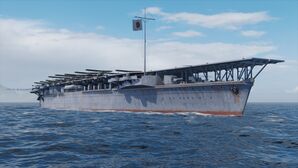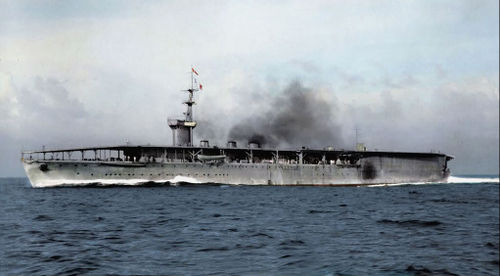Hosho
| Revision as of 08:31, 4 December 2017 Upgrade Rework. | Revision as of 19:54, 10 December 2017 | |||
| Line 6: | Line 6: | |||
| |Performance=<!-- write text about performance in battles below --> | |Performance=<!-- write text about performance in battles below --> | |||
| ? | Being the first IJN carrier in the line, ''{{#var:ship_name}}'' features a simple load-out that is easy for players new to carriers to use. She is a bomber-friendly guidance for players, as | + | Being the first IJN carrier in the line, ''{{#var:ship_name}}'' features a simple load-out that is easy for players new to carriers to use. She is a bomber-friendly guidance for players, as its squadron load-out boasts two 4-man squadrons of torpedo bombers, allowing for players to test out a variety of ways in which they can bomb their target. Moreover, ''Hosho'' holds a maximum of one squadron-full of reserves for each squadron, which is much more forgiving than her USN counterpart. However, its single fighter squadron may be problematic when ''{{#var:ship_name}}'' has to deal with its USN carrier counterpart, ''[[Langley]]''. Also note that ''{{#var:ship_name}}'' does not contain any dive-bombers, which means Captains will not gain any experience in their use until they unlock ''[[Zuiho]]''; experienced ''Langley'' Captains will be sure to exploit such. They key to success in ''{{#var:ship_name}}'' is leaning how to properly overwhelm your target with two torpedo squadrons, whilst using your fighter squadron to protect your strike aircraft from harassment. Preferred targets to strike will be slow, unaware, and isolated. In all, she is a good carrier that can teach newcomers carrier play that favors bombing the enemy. | |
| |Pros=<!-- write list of positive points below. use * as in ordinary wiki-list. --> | |Pros=<!-- write list of positive points below. use * as in ordinary wiki-list. --> | |||
| Line 12: | Line 12: | |||
| *2 torpedo squadrons provide fearsome striking capability | *2 torpedo squadrons provide fearsome striking capability | |||
| *Powerful propulsion, allowing it to keep up with the team | *Powerful propulsion, allowing it to keep up with the team | |||
| ? | *Only fighters | + | *Only fighters and torpedo bombers; makes it easy to micromanage aircraft | |
| *Slightly stealthier than ''Langley'' | *Slightly stealthier than ''Langley'' | |||
| Line 50: | Line 50: | |||
| | Aircraft Servicing Expert = 3 | | Aircraft Servicing Expert = 3 | |||
| | Direction Center for Catapult Aircraft = | | Direction Center for Catapult Aircraft = | |||
| ? | | Dogfighting Expert = | + | | Dogfighting Expert = 1 | |
| | Incoming Fire Alert = | | Incoming Fire Alert = | |||
| | Evasive Maneuver = 3 | | Evasive Maneuver = 3 | |||
| ? | | High Alert = | + | | High Alert = 1 | |
| | Jack of All Trades = | | Jack of All Trades = | |||
| | Expert Marksman = | | Expert Marksman = | |||
| Line 192: | Line 192: | |||
| With tensions rising in China in the early 1930s, ''Hosho'' – along with the rest of the Third Fleet – was stationed near Shanghai and covered Japanese operations through February and March. She was the first IJN ship to conduct aerial operations; mainly in the way of air-superiority, bomber escort, and airfield raids. | With tensions rising in China in the early 1930s, ''Hosho'' – along with the rest of the Third Fleet – was stationed near Shanghai and covered Japanese operations through February and March. She was the first IJN ship to conduct aerial operations; mainly in the way of air-superiority, bomber escort, and airfield raids. | |||
| ? | From late 1935 to early 1936, ''Hosho'' was spending time in the dockyards after suffering damage from a typhoon while undergoing a training sortie with the Fourth Fleet. The entire first half of the flight deck had to be rebuilt and reinforced after the original one collapsed and had to be | + | From late 1935 to early 1936, ''Hosho'' was spending time in the dockyards after suffering damage from a typhoon while undergoing a training sortie with the Fourth Fleet. The entire first half of the flight deck had to be rebuilt and reinforced after the original one collapsed and had to be cut away. Also while in the dockyards, measures were taken to decrease her top weight; funnels permanently swivelled horizontally, aircraft crane and upper deck aviation fuel tanks were deleted. | |
| ''Hosho'' was stationed back in China with the Third Fleet after the Second Sino-Japanese War commenced in the late 1930s. During the summer of 1937, ''Hosho’s'' air groups were tasked with bomber interdiction and close-air support to assist the Imperial Japanese Army operations near Shanghai. By autumn of 1937, ''Hosho'', along with ''[[Ryujo]]'', operated off the south China coast conducting further raids against Chinese airfields. | ''Hosho'' was stationed back in China with the Third Fleet after the Second Sino-Japanese War commenced in the late 1930s. During the summer of 1937, ''Hosho’s'' air groups were tasked with bomber interdiction and close-air support to assist the Imperial Japanese Army operations near Shanghai. By autumn of 1937, ''Hosho'', along with ''[[Ryujo]]'', operated off the south China coast conducting further raids against Chinese airfields. | |||
Revision as of 19:54, 10 December 2017
| 140 mm/50 3rd Year Type on a single mount4 х 1 pcs. |
| Firing Range3.5 km. |
| Rate of Fire7.5 shots/min. |
| Reload Time8 sec. |
| HE Shell140 mm HE Type0 |
| Maximum HE Shell Damage2,400 |
| Initial HE Shell Velocity850 m./s. |
| Chance of Fire on Target Caused by HE Shell10 % |
| 13 mm/76 Type 93 on a twin mount6 х 2 pcs. |
| . . . Average Damage per Second12 |
| . . . Firing Range1.2 km. |
| Maximum Speed25 knot |
| Turning Circle Radius740 m. |
| Rudder Shift Time11.1 sec. |
| Surface Detectability Range8.56 km. |
| Air Detectability Range6.46 km. |
Hōshō — Japanese Tier IV aircraft сarrier.
The first vessel in the world to be completed as a purpose-built aircraft carrier. This ship was moderately sized and could carry a small air group. For her size, she was armed with an impressive artillery setup and had decent speed and manoeuvrability.
Modules
 |
Speed (knot) | IDS_SHIP_PARAM_SQUADRON_MED_DAMAGE (HP/min) | IDS_SHIP_PARAM_SQUADRON_AMMO_AMOUNT | Hit Points (HP) |
Research price (exp) |
Purchase price ( | |
|---|---|---|---|---|---|---|---|
| A4N | 108 | 1,150 | 0 | 50,000 |
 |
Maximum Torpedo Damage (HP) | Speed (knot) | Hit Points (HP) |
Research price (exp) |
Purchase price ( | |
|---|---|---|---|---|---|---|
| B4Y Jean | 5,800 | 97 | 1,380 | 0 | 50,000 |
Compatible Upgrades
| Slot 1 |
|||
|---|---|---|---|
| Slot 2 |
Player Opinion
Performance
Pros:
- Has 16 torpedo bombers total, making it forgiving to lose some bombers during a run
- 2 torpedo squadrons provide fearsome striking capability
- Powerful propulsion, allowing it to keep up with the team
- Only fighters and torpedo bombers; makes it easy to micromanage aircraft
- Slightly stealthier than Langley
Cons:
- Only has 8 fighters, which makes it difficult to fight against Langley's potential 10 fighters
- No dive-bombers
- All Hōshō squadrons are smaller than Langley’s
- Un-armoured. HE shells will cause significant damage
Research
This is a suggested upgrade path:
- Yokosuka B4Y torpedo bombers
- Mitsubishi A5M4 fighters
- Hosho (B) Hull
Optimal Configuration
Upgrades
The recommended upgrades for Hōshō are as follows:
- Slot 1: Air Groups Modification 1

- Slot 2: Damage Control System Modification 1

Commander Skills
As Hōshō is a Tier IV carrier with only one 4-man squadron of fighters and no dive bombers, it's best to choose the following recommended skills. Players can opt to sacrifice Emergency Takeoff and Dogfighting Expert skills for Concealment Expert (which would reduce her detection to 7.1km when coupled with camouflage), but Hōshō already has sufficient stealth and speed to avoid detection by enemy ships. Therefore, Concealment Expert is not a highly recommended skill. Priority Target and Incoming Fire Alert are not really necessary because when a carrier is detected, the ship often becomes a priority target for many players.
Evasive Maneuvers is not recommended because it only affects bombers that have dropped their payload and are returning to the carrier.
ATTENTION
- As of Update 0.6.3, this carrier can no longer use manual / Alt function attack.
| Recommended Commander Skills | ||||||||
|---|---|---|---|---|---|---|---|---|
| Cost (points) |
Endurance | Attack | Support | Versatility | ||||
| 1 |
|
|
|
★★★ |
|
|
|
|
| 2 |
★ |
|
|
★★★ |
|
|
|
|
| 3 |
|
|
★★★ |
|
★ |
|
|
|
| 4 |
|
|
|
|
★ |
|
|
★★ |
| Key: ★★★ - Extremely Useful ★★ - Frequently Useful ★ - Occasionally Useful No stars - Meh Χ - Not recommended | ||||||||
Consumables
As a carrier at Tier IV, Hōshō has access to only Damage Control Party ![]() .
.
Camouflage
Type 1, 2, or 5 camouflage can be equipped for credits; Types 1 or 5 are recommended at a minimum to reduce chances of being detected by the enemy.
Signals
As a carrier, Hōshō can only mount at most four signals at a time and has no risk of detonating. Players should mount Equal Speed Charlie London (for faster XP grinding / increased XP gain per battle), Zulu Hotel (when coupled with Equal Speed Charlie London greatly helps increase commander (re)training), and Juliet Whiskey Unaone (to have a better chance at causing flooding and dealing damage via flooding). However, Juliet Whiskey Unaone is not highly recommended if the player wishes to conserve the signal for later tiers.
Recommended Signal Flags 
| |||||
|---|---|---|---|---|---|
| Combat | |||||

|

|

|

|

|

|
 ★★ |

|

|
 ★ |

|

|

|

| ||||
Note: Use of the Juliet Charlie signal makes detonation impossible.
Gallery
Historical Info
Historical Gallery
References
- Stille, M., Bryan, T. (2005) Imperial Japanese Navy Aircraft Carriers: 1921-45. Oxford, UK: Osprey Publishing Ltd.
- Chesneau, R., Gardiner, R. (1980). Conway’s All the World’s Fighting Ships, 1922-1946. London, UK: Conway Maritime Press.
- Sha, S. K. (1964). Japanese Aircraft Carriers and Destroyers: Vol 2. London, UK: Macdonald & Co. Ltd.
| Japan | IV Hōshō • VI Ryūjō • VIII Shōkaku • VIII Kaga |
| U.K. | IV Hermes • VI Furious • VI Ark Royal |
| France | VI Béarn |
| U.S.S.R. | IV Komsomolets • VI Serov • VIII Pobeda • VIII Chkalov |
| U.S.A. | IV Langley • VI Independence • VI Ranger • VIII Yorktown • VIII Lexington • VIII Enterprise |
| Germany | IV Rhein • VI Weser • VI Erich Loewenhardt |
| Pan-Asia | VIII Sanzang |
| Spain | |
| Europe | |
| Netherlands | |
| Italy | VIII Aquila |
| Commonwealth | |
| Pan-America |




















